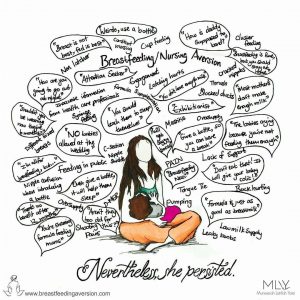What is the phenomenon of Breastfeeding Aversion and Agitation (BAA)?
BAA or ‘aversion’ is a phenomenon that some breastfeeding mothers experience, which includes having particular negative feelings, often coupled with intrusive thoughts when an infant is latched and suckling at the breast (Yate, 2017).
The two days before I get my period, I get nursing aversion at night. This usually feels like being very agitated, and the need to get my baby off me and what only be described as extreme itching all over my body but under the skin.” –Nadia
These feelings are often unexpected, and almost always unwanted, as many mothers who experience aversion would like to continue breastfeeding. Mothers can experience feelings of:
Now infants can get
all their vitamin D
from their mothers’ milk;
no drops needed with
our sponsor's
TheraNatal Lactation Complete
by THERALOGIX. Use PRC code “KELLY” for a special discount!
- Anger
- Agitation
- Disgust/Self-Disgust
- Irritability
- Rage
- Skin itching/crawling
- Shame & Guilt (usually afterwards)
Intrusive thoughts are known to occur in motherhood (Kleiman, 2010), but with BAA these appear to be specific to breastfeeding and can include, but are not at all limited to:
- Wanting to ‘run away’ so as to not be feeding
- Overwhelming urge to stop breastfeeding
- ‘Feeling trapped’ or a like a prisoner
- Wanting to ‘pinch’ the infant or child so they stop suckling
- Thoughts and feelings about being ‘touched out’
These feelings disappear after the infant stops breastfeeding and is not latched.
The phenomenon of BAA is known to exist in varying degrees and durations, along a spectrum that is individual for each mother – as the onset and severity is unpredictable. However, the expression or manifestation of aversion is similar, with mothers describing very similar feelings and thoughts, often using the exact same phrases (Yate, 2017).
I didn’t actually know there was a term for this. I get so angry, like a rage when my son latches now, and I am not sure why. I used to LOVE breastfeeding and we had such a good relationship. All I think about now is leaving, running away when he suckles. Then I feel so guilty it hurts.” –Hanna
Guilt and Shame
Mothers feel a great sense of shame and guilt due to these negative feelings and intrusive thoughts. Many don’t tell anyone, and struggle with an ‘internal conflict’ of wanting to breastfeed, but once engaging in the activity, experiencing aversion toward it. Some mothers have to wean due to experiencing BAA, if it is long-lasting or severe, or if they do not know what it is. This also can cause feelings of guilt over having to end breastfeeding before a mother or infant was ready.
I am so glad I found this group [online support group]; I thought I was going mad… that I was the only one who felt like this when nursing. I just want to scream and pull my baby off.” –Preena
Is BAA like Dysphoric-Milk Ejection Reflex (D-MER)?
In the experience of negative emotions whilst breastfeeding, yes. However, for mothers who experience BAA, there is often an overwhelming urge to de-latch the suckling infant, as once aversion hits it will not abate until the infant has stopped suckling. This is noted in distinction to the condition of D-MER, which is the experience of feelings of dysphoria when the milk releases, as these dissipate shortly thereafter – not staying throughout the whole feed as is the case with BAA. The feelings themselves are also generally different: anger and agitation are not the same emotions as dread, despair or sadness, although there can be crossovers. Mothers can experience both D-MER and BAA, and at the same time, but they are different phenomenons.
What causes BAA?
The paucity of research on BAA is very apparent, there are no research studies that investigate what causes aversion experienced in this manner whilst breastfeeding. There are a few academic studies and books that mention it. Recently, in 2016, a small group of women were interviewed in a study that concluded that breastfeeding can trigger ‘negative embodied emotions’, which are negative feelings that are projected onto the infant, and aversion was referred to (Watkinson, et.al 2016). Adventures in Tandem Nursing by Hilary Flower refers mainly to women who are pregnant or tandem nursing experiencing ‘agitation’ at the breast (Flower, 2003). However, in a study asking 694 women to describe the phenomenon of aversion, there was no distinction found between mothers breastfeeding a single infant and those who were pregnant or tandem feeding (Yate, 2017). Possible causes from other published works in parenting and lactation that could lend some understanding towards the reasons for BAA are discussed. These are grouped loosely under the following categories in the discussion section of the study:
Hormones
Some mothers are able to tie experiences of BAA to their menstruation (even ovulation), and manage it for a few days each month, once they have identified this pattern, and they realise it will pass. This indicates that the cause could be hormonal for some women, something perhaps similar to pre or postmenstrual stress. It is also likely to be hormonal for the women that get a bout of BAA in pregnancy as the body changes, breast and nipple sensitivity is heightened, and overall energy ‘costs’ on a woman’s body to fulfill both gestation and lactation all plausibly playing a role. It is possible for some women that aversion is their bodies’ way of suggesting weaning (Neville, 2010. Hinde, K, 2009, Grey, 2013).
Breastfeeding dynamic
Many women write they experience aversion once their infant starts to get a bit older (i.e., is not a baby), and they still maintain ‘feeding on demand’. There could be a number of reasons for this, including the difficulty to say no or ‘set boundaries’ with their child, or the fact the child is less reliant on milk for survival but is still breastfeeding very frequently, even at night. The breastfeeding relationship is an important consideration in the experience of BAA, because if mothers have unrealistic expectations on infant sleep due to societal or cultural pressures, are the only source of milk, coupled with the decline of a ‘tribe’ or milk-sharing duties/wet nursing over the past few decades, this can put the pressure and stress on the mother alone for milk. It is plausible this stress can manifest whilst breastfeeding and in the interactions of the mother-infant dyad at this time, especially considering the hormone cortisol (Hinde, K, 2014).
Sleep deprivation and ‘self-care’
Lack of sleep can affect us in many ways, including causing chronic diseases, and even depression. This is well documented. The mothers who responded in the study would often note being sleep deprived in their responses, and how difficult it was for them to maintain breastfeeding on demand, especially at night, in this state. This is the one key area many mothers noted BAA would strike, often alongside not eating properly with a well-balanced diet, and not hydrating sufficiently.
Triggers
Sleep deprivation or not having any time for self-care are commonly reported as ‘triggers’ for BAA, including the sensations of an infant’s latch, ‘wandering hands’ and ‘nipple twiddling/tweaking’. Many mothers report the pre-cursor to experiencing aversion is that they are ‘touched out’. This term refers to women feeling overwhelmed by the amount of physical contact with their infants, and not being able to have any time apart/alone/for themselves without being touched. This was especially true for mothers who tandem fed, or were breastfeeding very demanding toddlers.
There is not enough research on BAA to know how many breastfeeding women it affects, why it affects some women and not others, and what women can do about it. There is anecdotal information that suggests cognitive distraction, taking certain supplements, and mother peer-to-peer support can help lessen the experience or manage it until it abates.
A resource website on Breastfeeding Aversion and Agitation, how to figure out what can help, and the latest research can be found here: www.breastfeedingaversion.com. If you are struggling with aversion you can join a closed online peer to peer support group on Facebook, or reach out on the public awareness page about aversion on Facebook, or Instagram @breastfeedingaversion.
References
- Yate ZM. A qualitative study on negative emotions triggered by breastfeeding; describing the phenomenon of breastfeeding/nursing aversion and agitation in breastfeeding mothers. Iran J Nurs Midwifery Res. 2017 Nov-Dec; 22(6): 449–454. doi: 10.4103/ijnmr.IJNMR_235_16.
- Watkinson M, Murray C, Simpson J. Maternal experience of embodied emotional sensations during breast feeding: An Interpretative Phenomenological Analysis. Midwifery 2016;36:53‐60.
- Flower H, O’Mara P. Adventures in Tandem Nursing: Breastfeeding During Pregnancy and Beyond. Schaumburg Ill: La Leche League International; 2003. p. 327.
- Heise AM, Wiessinger D. Dysphoric milk ejection reflex: A case report. Int Breastfeed J 2011;6:6.
- Neville MC, Anderson SM, McManaman JL, Badger TM, Bunik M, Contractor N, et al. Lactation and Neonatal Nutrition: Defining and Refining the Critical Questions. J Mammary Gland Biol Neoplasia 2012;17:167‐88.
- Hinde K. Richer milk for sons but more milk for daughters: Sex‐biased investment during lactation varies with maternal life history in rhesus macaques. Am J Hum Biol 2009;21:512‐9.
- Amir LH, Dennerstein L, Garland SM, Fisher J, Farish SJ. Psychological aspects of nipple pain in lactating women. J Psychosom Obstet Gynaecol 1996;17:53‐8.
- Picciano MF. Pregnancy and Lactation: Physiological Adjustments, Nutritional Requirements and the Role of Dietary Supplements. J Nutr 2003;133:1997S‐2002S.
- Ussher JM, Perz J. PMS as a process of negotiation: Women’s experience and management of premenstrual distress. Psychol Health 2013;28:909‐27.
- Neville MC, Morton J. Physiology and Endocrine Changes Underlying Human Lactogenesis II. J Nutr 2001;131:3005S‐8S.
- Hinde K, Skibiel AL, Foster AB, Rosso LD, Mendoza SP, Capitanio JP. Cortisol in mother’s milk across lactation reflects maternal life history and predicts infant temperament. Behav Ecol 2014;26:269‐81.
- Hinde K, Capitanio JP. Lactational programming? Mother’s milk energy predicts infant behavior and temperament in rhesus macaques (Macaca mulatta). Am J Primatol 2010;72:522‐9.
- Grey KR, Davis EP, Sandman CA, Glynn LM. Human milk cortisol is associated with infant temperament. Psychoneuroendocrinology 2013;38:1178‐85.
- Borra C, Iacovou M, Sevilla A. New Evidence on Breastfeeding and Postpartum Depression: The Importance of Understanding Women’s Intentions. Matern Child Health J
2014;19:897‐907. - Kleiman K, Wenzel A. Dropping the Baby and Other Scary Thoughts: Breaking the Cycle of Unwanted Thoughts in Motherhood. New York, NY: Routledge; 2010. p. 272.


 Iranian born Zainab Yate is Vice Chair of North London Research Ethics Committee, for the Health Research Authority (HRA), and a member of King’s College London (KCL) Research Governance Board in the UK. She volunteers as a breastfeeding peer supporter with the National Health Service (NHS), and is volunteering to support the work of World Breastfeeding Trends initiative (WBTi) in the UK. As an independent researcher and research consultant, with two breastfed toddlers, she spends her free time raising awareness of BAA and supporting mothers who experience it. In September 2017, she hopes to start an online structured programme for mothers who experience BAA, to help them reach their breastfeeding goals.
Iranian born Zainab Yate is Vice Chair of North London Research Ethics Committee, for the Health Research Authority (HRA), and a member of King’s College London (KCL) Research Governance Board in the UK. She volunteers as a breastfeeding peer supporter with the National Health Service (NHS), and is volunteering to support the work of World Breastfeeding Trends initiative (WBTi) in the UK. As an independent researcher and research consultant, with two breastfed toddlers, she spends her free time raising awareness of BAA and supporting mothers who experience it. In September 2017, she hopes to start an online structured programme for mothers who experience BAA, to help them reach their breastfeeding goals.